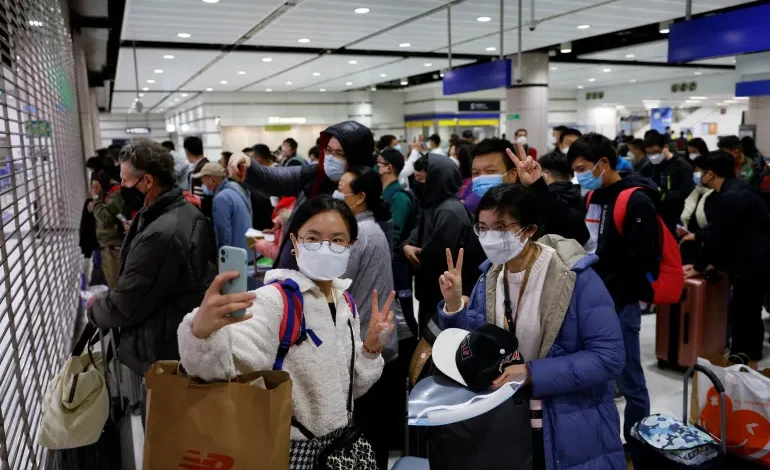Excitement as China opens borders to quarantine-free travel

China has lifted pandemic restrictions on foreign travel, ending quarantine requirements for inbound travellers and with it, nearly three years of self-imposed isolation.
The first passengers to arrive under the new rules landed at airports in the southern cities of Guangzhou and Shenzhen just after midnight on Sunday, according to the state-owned China Global Television Network (CGTN).
The 387 passengers on board flights from Singapore and Canada’s Toronto were not subject to COVID-19 tests on arrival and did not have to undergo five days of quarantine at centralised government facilities, it reported.
The easing of curbs on foreign travel marks the final unravelling of China’s strict “zero-COVID” policy.
Beijing began dismantling the hardline strategy of mandatory quarantines, gruelling lockdowns and frequent testing following historic protests against the curbs last month. But the abrupt changes have exposed many of its 1.4 billion population to the virus for the first time, triggering a wave of infections that is overwhelming some hospitals, emptying pharmacy shelves of medicines, and causing long lines to form at crematoriums.
The lifting of quarantine rules effectively opens the door for many Chinese to go abroad for the first time since borders slammed shut nearly three years ago, without fear of having to isolate at government facilities on their return.
China’s borders remain closed to tourists, however, with foreigners only allowed to travel to the country for business or family visits.
Al Jazeera’s Katrina Yu, reporting from Beijing, said that for many people in China, Sunday marked “the real end of the ‘zero-COVID’ policy”.
“That’s because, before today, it was impossible to leave and enter China without having to undergo quarantine at government facilities and at home. So people feel very excited and quite liberated to go and travel outside the country,” she said. “Popular travel sites say searches for outbound flights have jumped by about 80 percent compared with this time last year, and the favourite destination was Thailand. Others include Japan, South Korea, the US and Australia,” she added.
Beijing has called the travel curbs “unacceptable”.
Despite the testing requirements, 28-year-old Zhang Kai told the AFP news agency he is planning a trip to either South Korea or Japan.
“I am happy, now finally [I can] let go,” Zhang said.
Friends of his have already landed in Japan and undergone tests, he said, dismissing the testing requirement as a “small matter”.
In Tokyo, caricaturist Masashi Higashitani said he was thrilled about China’s reopening and was dusting off his Chinese language skills to prepare for more holidaymakers. But he admitted some apprehension.
“I wonder if an influx of too many of them might overwhelm our capacity. I’m also worried that we need to be more careful about anti-virus measures,” he told AFP.
Experts say while concerns about travellers from China were understandable, given the scale of the outbreak in the country, the likelihood of Chinese passengers causing a spike in infections in the countries they visit was minimal.
“People have reason to be concerned about high volume of travellers from China,” said Yanzhong Huang, a senior fellow for global health at the Council on Foreign Relations, a United States-based think tank.










